When the Zenith Chronomaster Sport won the Chronograph Prize at the 2021 Grand Prix d’Horlogerie Genève, the watch world’s most prestigious awards, it was emphatically something new and different: the first chronograph watch able to measure 1/10-second chronograph readings on its bezel scale. However, despite the fact that the Chronomaster Sport collection can still be considered “new” in a practical sense, its origins, both aesthetic and technical, can be traced back much further, all the way to some of the earliest horological milestones of Zenith, one of the Swiss watch world’s most honored and accomplished watchmakers and the inventor of the groundbreaking movement that animates all the Chronomaster models, including the Sport. I spoke with Zenith’s Head of Heritage, Laurence Bodenmann, to help trace the evolution of the Chronomaster Sport and its strong ties to several noteworthy models of the past.

Zenith traces its impactful watchmaking history all the way back to 1865, and an ambitious 22-year-old watchmaker named George Favre-Jacot. A contemporary of the influential Swiss artist and designer Le Corbusier, a pioneer of avant-garde architecture, Favre-Jacot adopted a similarly modernist approach to watchmaking when he founded his atelier in Le Locle in the Swiss Jura. Taking cues from American watch firms like Waltham and Elgin, which had found success by introducing mass production into the traditionally artisanal trade, Georges Favre-Jacot & Co., the forerunner of Zenith, was the first Swiss watch manufacturer to bring the various disciplines of horology under one roof.Until then, most all Switzerland’s watchmaking houses depended on the so-called établissage system, in which different parts were made in different small workshops before being delivered to another workshop for assembly into a finished watch. This type of vertical integration gave rise to what we today refer to as the “manufacture d’horlogerie,” or simply “manufacture,” a status that even today very few watch companies can claim. From the beginning, Favre-Jacot was determined to create timepieces of uncommon reliability and accuracy.
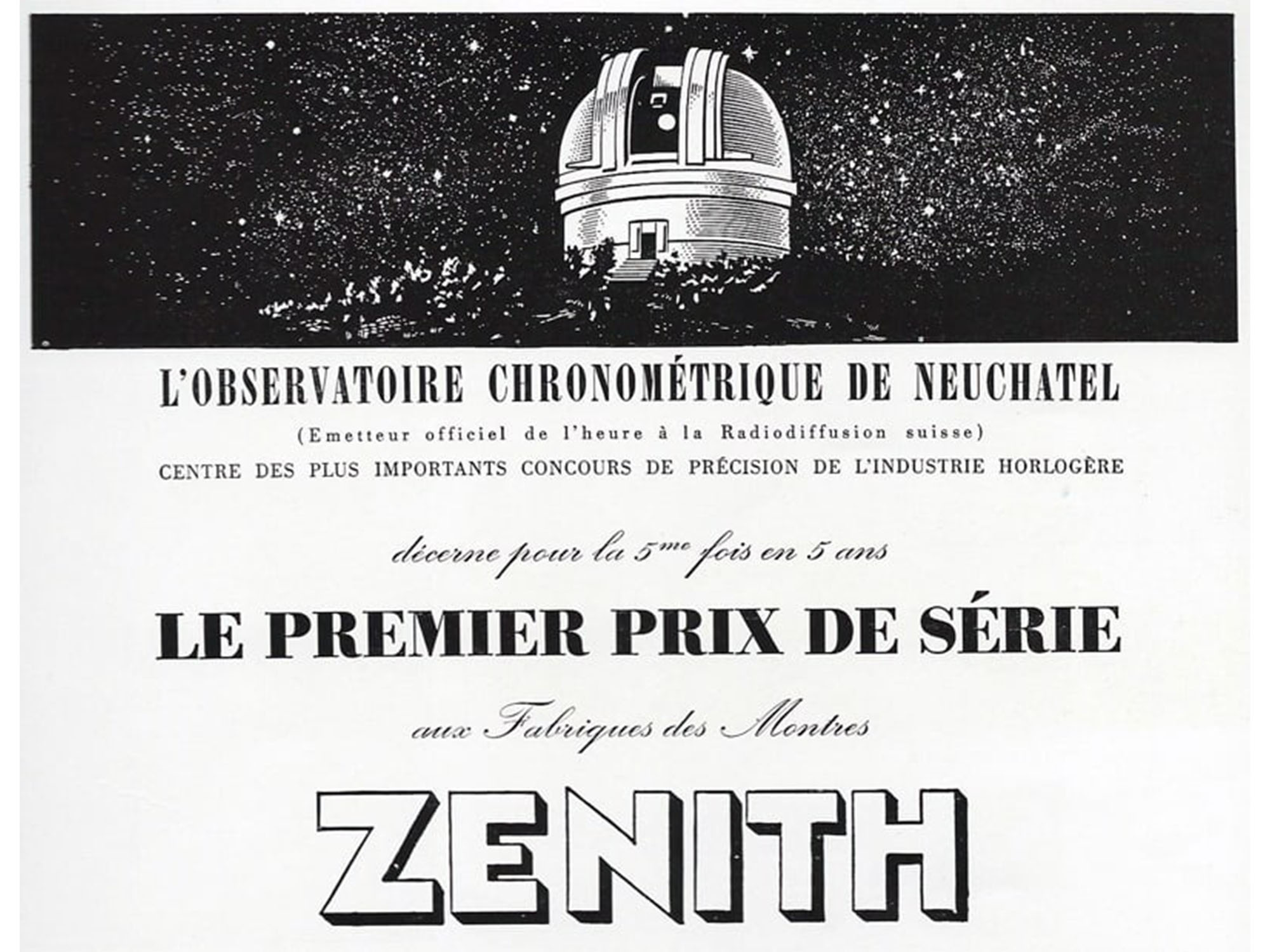
In 1900, George Favre-Jacot & Co. won the Grand Prix chronometry award at the Paris World’s Fair for a high-precision watch movement that it had created in 1897 and submitted to the competition. The prize-winning movement, called “Zenith” because it was designed to achieve the pinnacle of precision timekeeping at the time, would lend its name to the company in 1911. The renamed Zenith firm went on to win 2,330 chronometry prizes over the years, many at Switzerland’s famed Neuchatel Observatory — a record that still stands, and which established Zenith as a leader in the pursuit of timekeeping precision.
This organizational pursuit of timekeeping excellence found its most lasting milestone in the arena of chronographs, a type of timepiece that experienced a steady growth in popularity during the early part of the 20th Century after being more of a niche-oriented tool at the end of the 19th. According to Laurence Bodenmann, Zenith’s Head of Heritage, Zenith was at the vanguard of the industry-wide quest to develop an in-house chronograph caliber from its earliest days, when pocket watches still ruled as the go-to portable timekeeper. “At the end of the 19th Century, there were chronograph movements signed Zenith but not a chronograph movement of true Zenith origin,” Brodenmann reveals. “Demand for chronograph timers wasn’t that high at the time, and watch companies preferred working with specialists to make them. Even here, however, Zenith was ahead of its time; in 1913, Zenith bought the neighboring company that made their base caliber and used that caliber for its pocket watches. The first Zenith wristwatch chronograph appeared in 1920, and like the pocket watches originally, it used outside movements from companies like Valjoux, and especially from a company called Martel Watch Company, which also made movements for Universal Genève, for their Compax watches. These movements were signed ‘Zenith’ but produced outside. The turning point for wristwatch chronographs was 1959.”
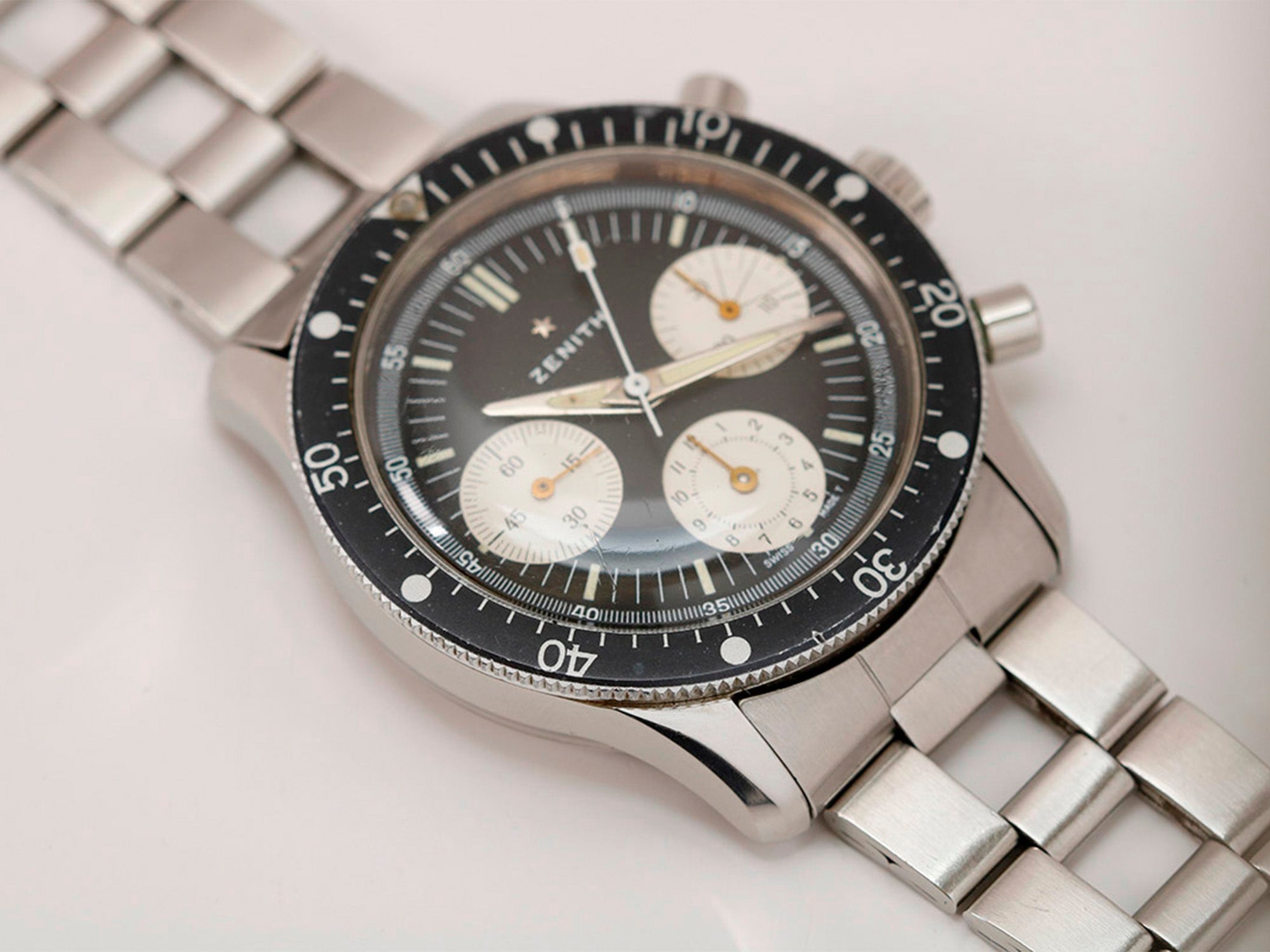
That was the year, Bodenmann goes on to explain, that Zenith acquired Martel, which had been “dropped like a sock” as a movement supplier for Universal, at Martel’s request. The result was that Martel Watch was integrated into Zenith as the firm’s chronograph laboratory and development department; its first accomplishment was Zenith Caliber 146, the manually wound chronograph movement that animated what are now referred to as “pre-El Primero” watches, most famously the Ref. A277 (above, photo via Matthew Bain), produced from 1968 to 1970. One can see some of the Chronomaster Sport’s DNA in this vintage model, like the contrasting subdials, the rotating bezel with baton and dot markers, and the pump-style chronograph pushers.
In 1962, with its 100th anniversary in 1965 looming, Zenith decided to tackle the biggest technical challenge that had faced the watch industry to that point: the invention of a self-winding mechanical chronograph movement. The result would be Zenith’s most important technical contribution to watchmaking history, and the one that would forge its identity in the modern era. Zenith missed its self-imposed deadline to complete the project in its centennial year, and other watch manufacturers — including Breitling, Heuer-Leonidas, and Seiko — began throwing their hats in the ring subsequently, all vying to lay claim to the first great horological invention of the 20th century. As I delve into in much greater detail here, Zenith’s El Primero was “the first” of the automatic chronograph movements that hit the market on the cusp of the 1970s. “El Primero was something that hadn’t existed,” Bodenmann emphasizes. If you’d put an El Primero in a pre-El Primero chronograph watch, it wouldn’t work. A true automatic chronograph was different from what most Swiss companies were making during that time, which were ‘sandwiches’ [i.e., modules], built on existing base calibers. And Zenith didn’t just want El Primero to be automatic, they wanted to integrate the oscillating mass so that it was also the thinnest on the market. Remember, also, that it was designed in a day and age where they didn’t have computers, which helps to explain the lengthy development time. The goal was really the first modern chronograph, something that would revolutionize the way chronograph movements would be produced.”
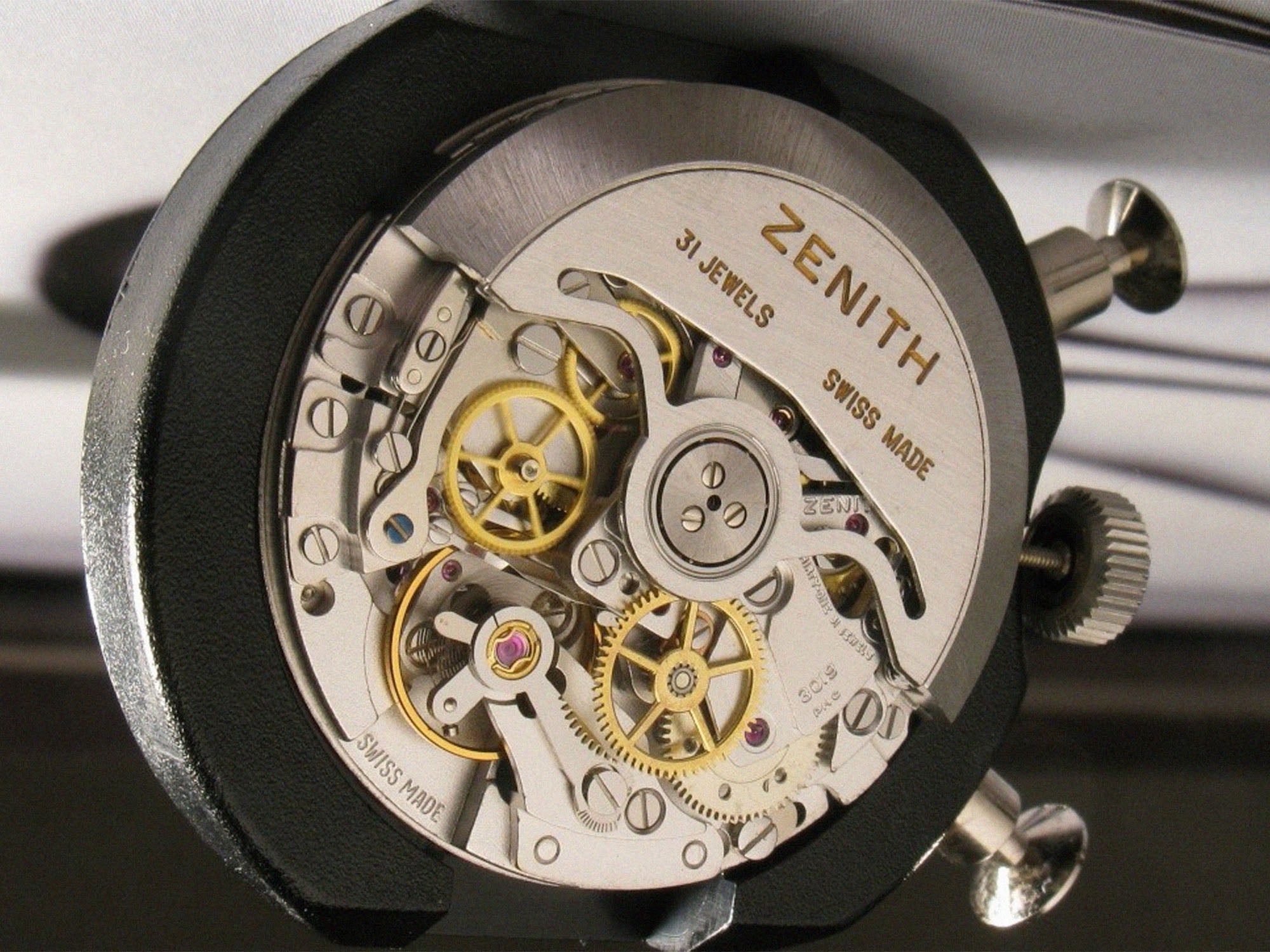
By just about any standard, Zenith’s years-long project was a success. The original El Primero caliber (above) was distinguished by Its unprecedented, lightning-quick balance frequency of 36,600 vph (5 Hz), which in practical terms meant that the built-in stopwatch function, driven by a classical column wheel, was capable of measuring elapsed times to 1/10th second. Despite the complexity endowed by its 278 parts, it measured just 6.5 mm in height, meaning watches that contained it could be similarly slim and wearable. The El Primero’s power reserve was nearly 50 hours, well above the standard at the time, thanks to its tungsten carbide rotor that maximized automatic winding.
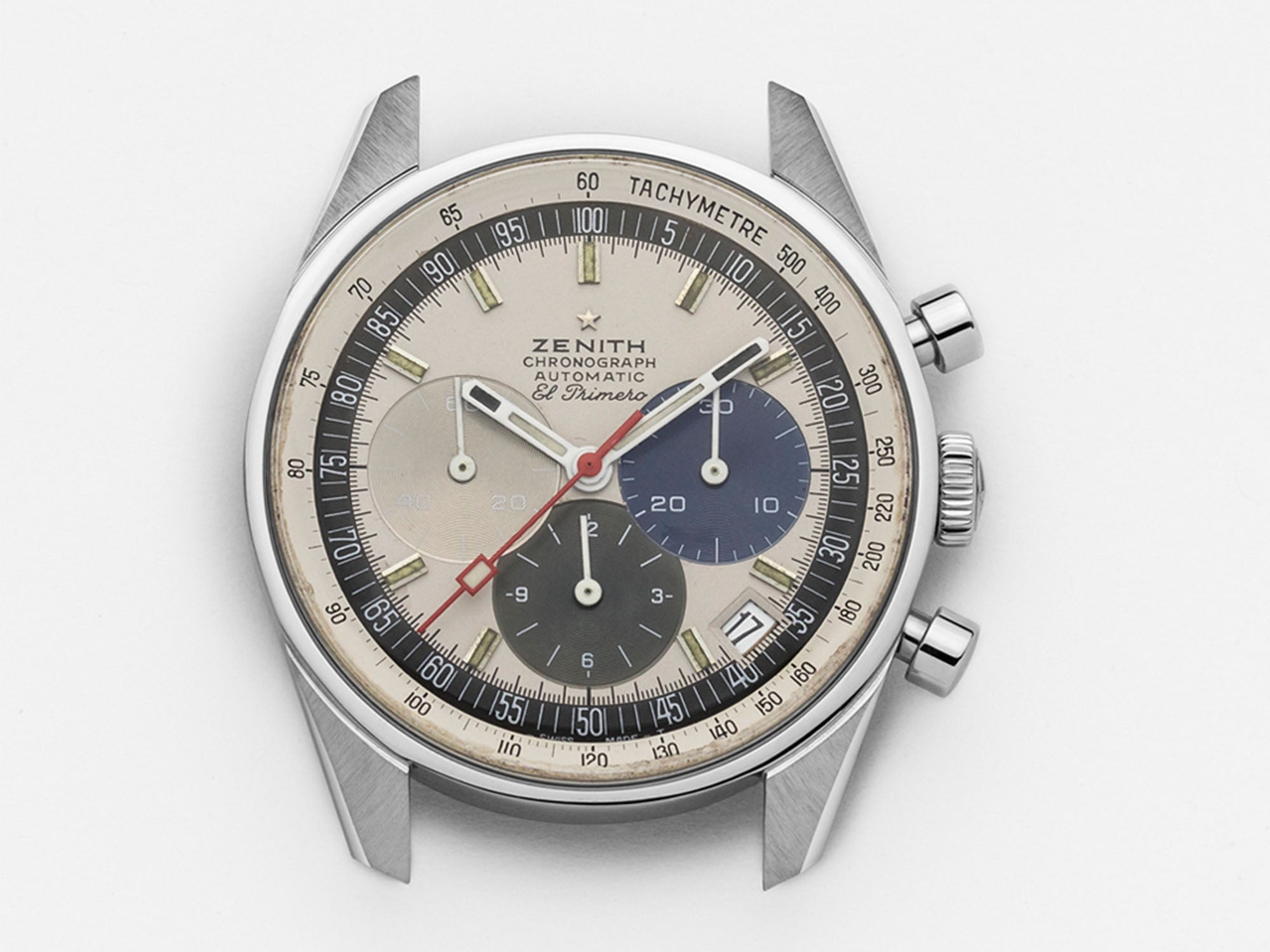
The first Zenith watches equipped with the El Primero caliber — the ancestors of the modern Chronomaster models, though they weren’t called by that name yet — hit retailers’ shelves in September 1969. The first of these models was the Ref. 384, which had a 37mm stainless steel tonneau case with mushroom-style pushers, and a three-register dial with three black subdials on a silvery white background (a style today widely known as a “panda” dial), a red central chronograph hand, and a tachymeter scale on its periphery. Following up that model and employing the same case design was Ref. A385, which sported, according to Zenith, the watch industry’s first gradient-effect “smoked” dial, cream-colored in the center radiating to brown and black at the edges, along with silvered white subdials. The model that would prove most durable and influential was Ref. A386 (above), which established the tricolor design that has become visual shorthand for a Zenith El Primero watch to this day: blue for the minute counter at 3 o’clock, gray for the hours counter at 6 o’clock, and silver for the running seconds at 9 o’clock. According to Bodenmann, such a dial configuration had never been executed on a commercial watch before. These seminal designs have been resurrected in modern-day the Chronomaster Original and Chronomaster Revival series (Revival A384 model pictured below), both tentpoles of Zenith’s collection and forerunners of the Chronomaster Sport.
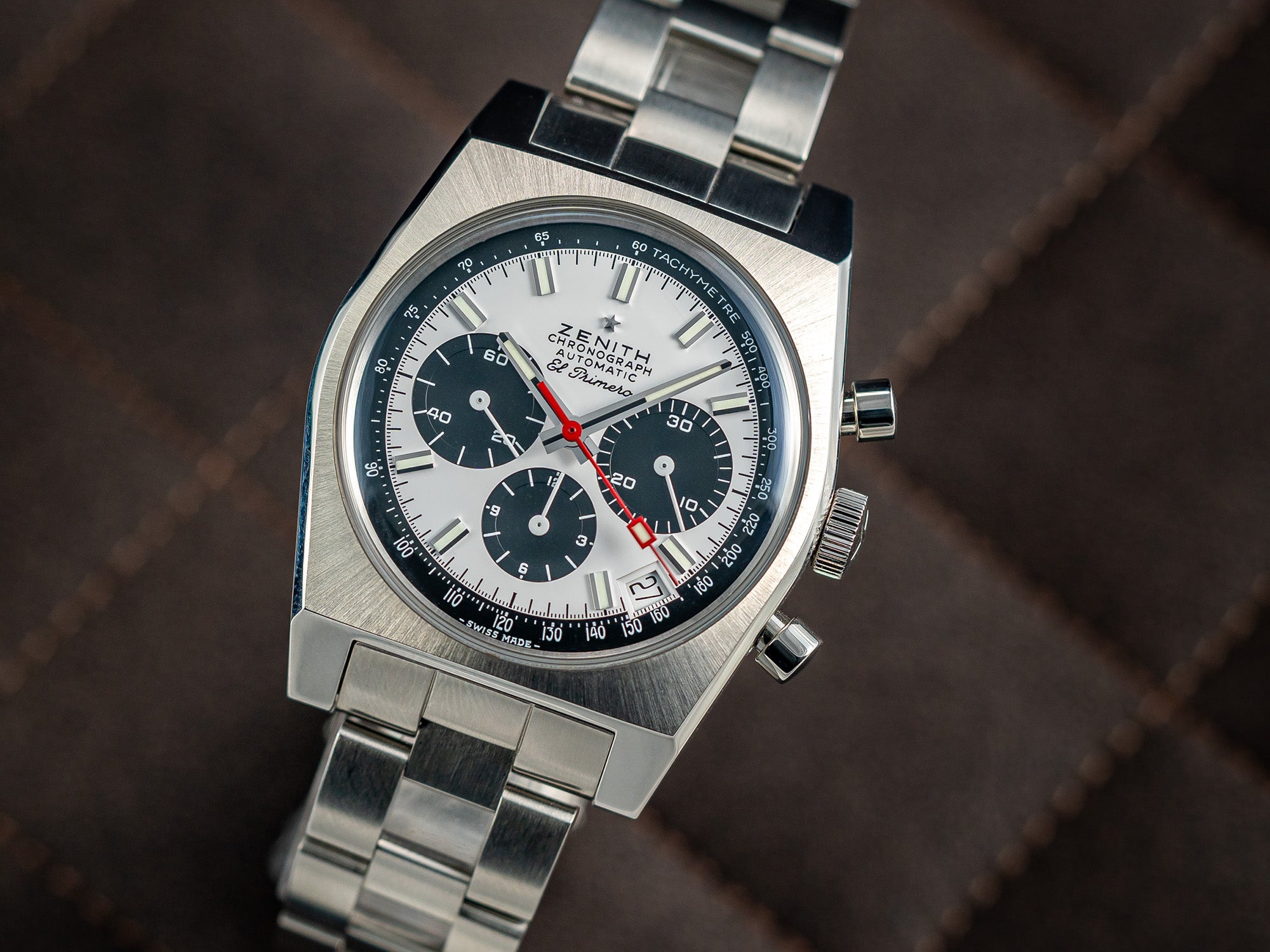
Like many traditional Swiss watchmaking firms, Zenith went through a series of ownership changes in the 1970s and ‘80s as consolidation began to take hold of the industry. In 1971, in a strange bit of corporate serendipity, the company was acquired by another company called Zenith, the USA’s Zenith Radio Company. This was during the heart of the so-called Quartz Crisis, an era in which watches with inexpensive quartz movements, mostly made in Asia, threatened to wipe out the trade of mechanical watchmaking to which most Swiss companies, including Zenith, still adhered. Not surprisingly, the TV- and radio producer that now called the shots regarded electronic timekeeping as the wave of the future, and mechanical movements, even one as technically groundbreaking as El Primero, as obsolete relics to be consigned to the dustbin of history.
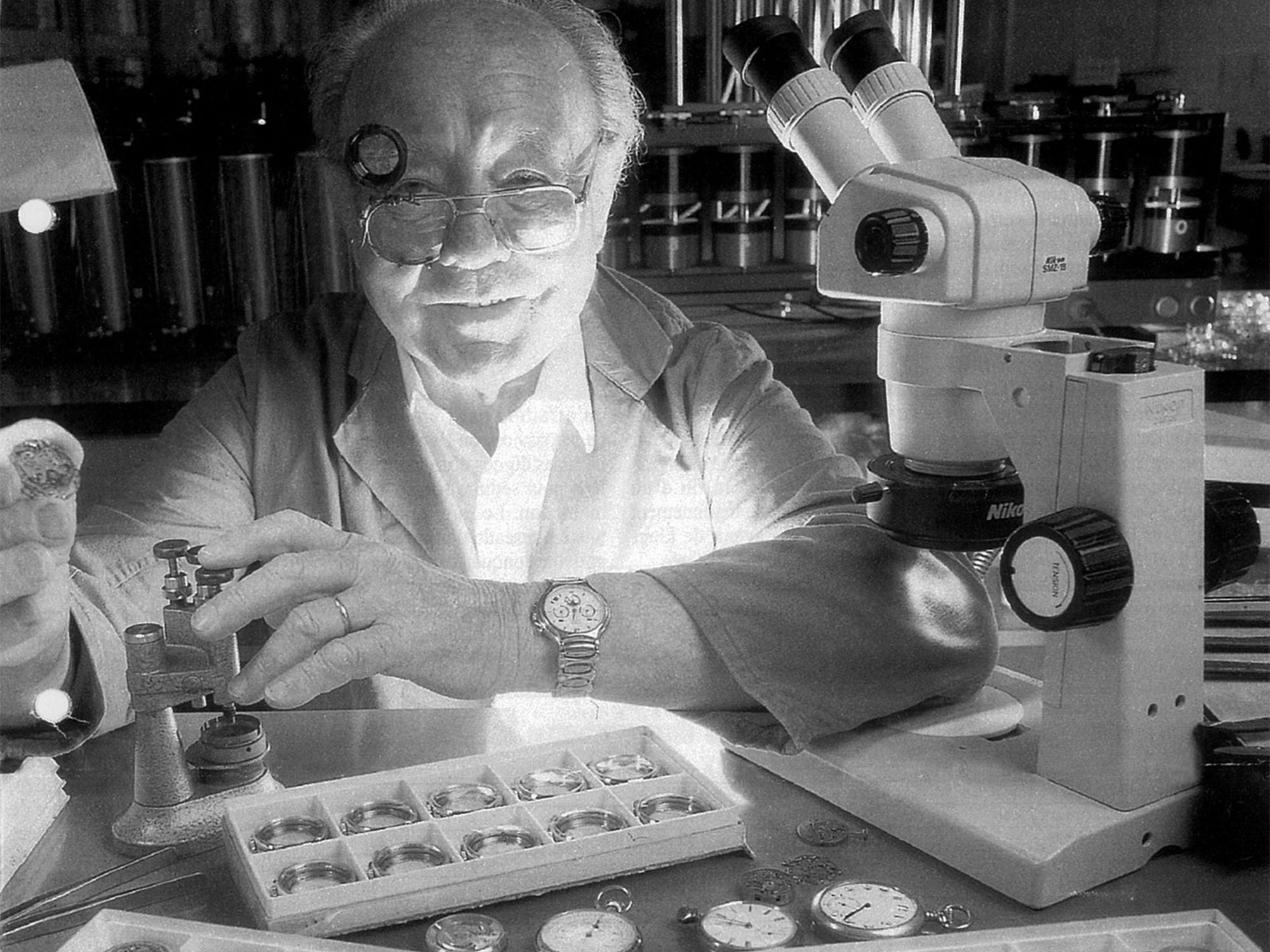
A corporate edict went out to Zenith’s team in Switzerland in 1975 to terminate mechanical watchmaking and gear up for an all-quartz future. However, the El Primero was rescued from oblivion thanks to the quiet insubordination of one of its employees, Charles Vermot (above), a senior engineer in Zenith’s movement-making department. Enlisting the aid of a handful of co-workers, Vermot secretly stashed all the El Primero blueprints and parts in a hidden attic at the factory (now preserved for posterity, see below) in the hopes of waiting out the turbulent quartz era and one day being able to resume production of the groundbreaking chronograph caliber.

“Charlie had to take it upon himself to preserve the El Primero, because at the time nobody above him cared,” said Bodenmann. “They didn’t have his vision of the future. He was told, ‘Charlie, these times are past.’ But his disobedience to that corporate vision had an enormous impact on the future of Zenith.” Vermot’s clandestine mission paid off in the 1980s, when first Ebel, then Rolex, re-committed to making mechanical chronograph watches and enabled the El Primero to emerge from hiding to become the engine at the heart of the latter’s mega-popular Daytona series. As the demand for mechanical luxury watches began ramping back up in the 1990s, Zenith followed suit with its own El Primero-equipped chronograph watches.
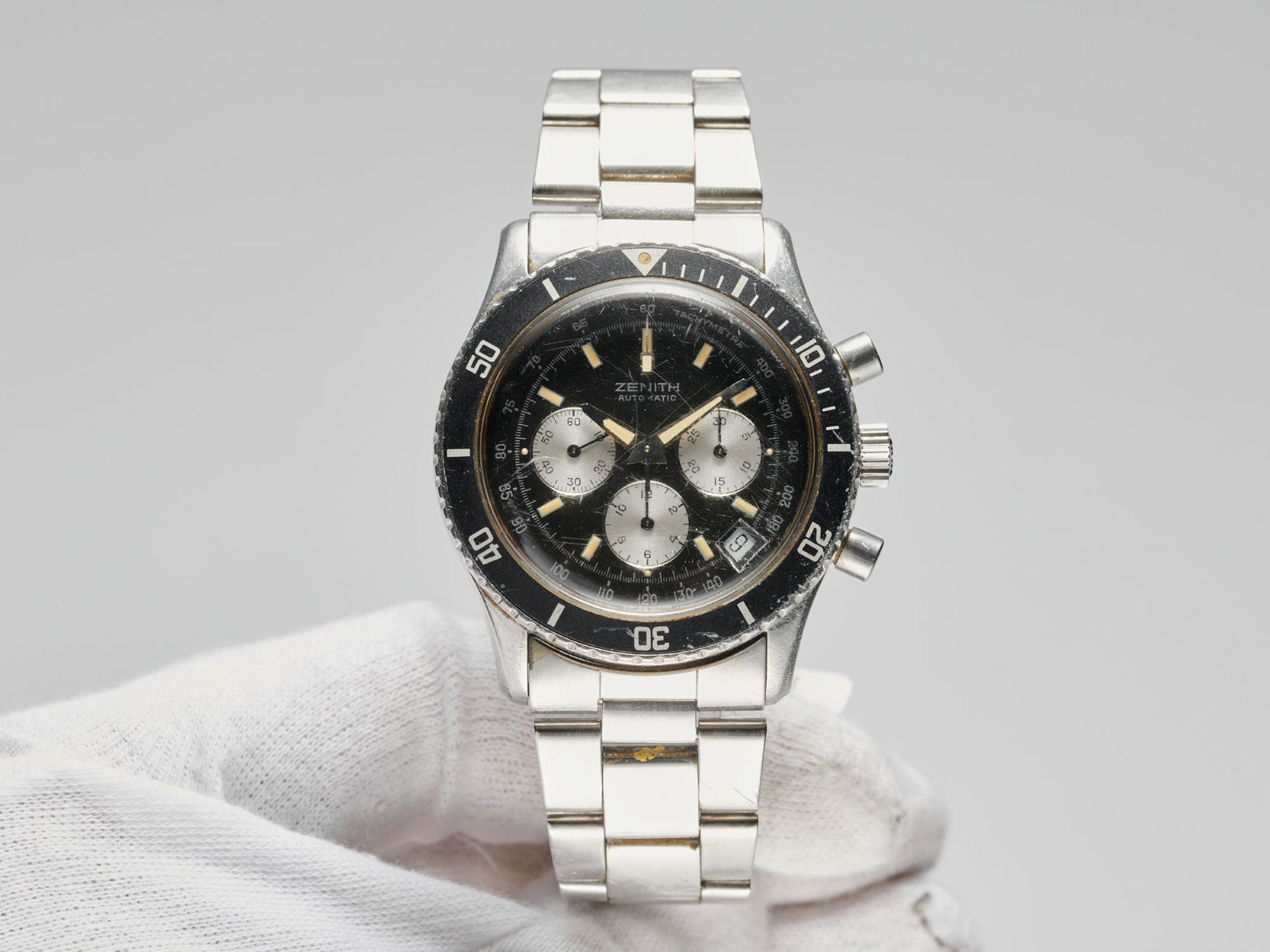
The most influential predecessor to the Chronomaster Sport surfaced in 1988. Powered by an El Primero caliber, the watch (above, photo via Ineichen Auctioneers) was nicknamed the “De Luca” after the Southern Italian retailer for the brand who had been involved in its creation. The De Luca’s noteworthy aspects included the bicolor “panda” dial, with contrasting subdials, the 40mm stainless steel case with downturned, chamfered lugs, and a bidirectional rotating 60-minute bezel, which gave way in later versions to a fixed bezel with a tachymeter scale, bringing it more in line aesthetically with the Rolex Daytona with whom it shared a movement, and heralding the fixed 1/10-second-scale bezel on the Chronomaster Sport. The El Primero De Luca models were produced through 1996.
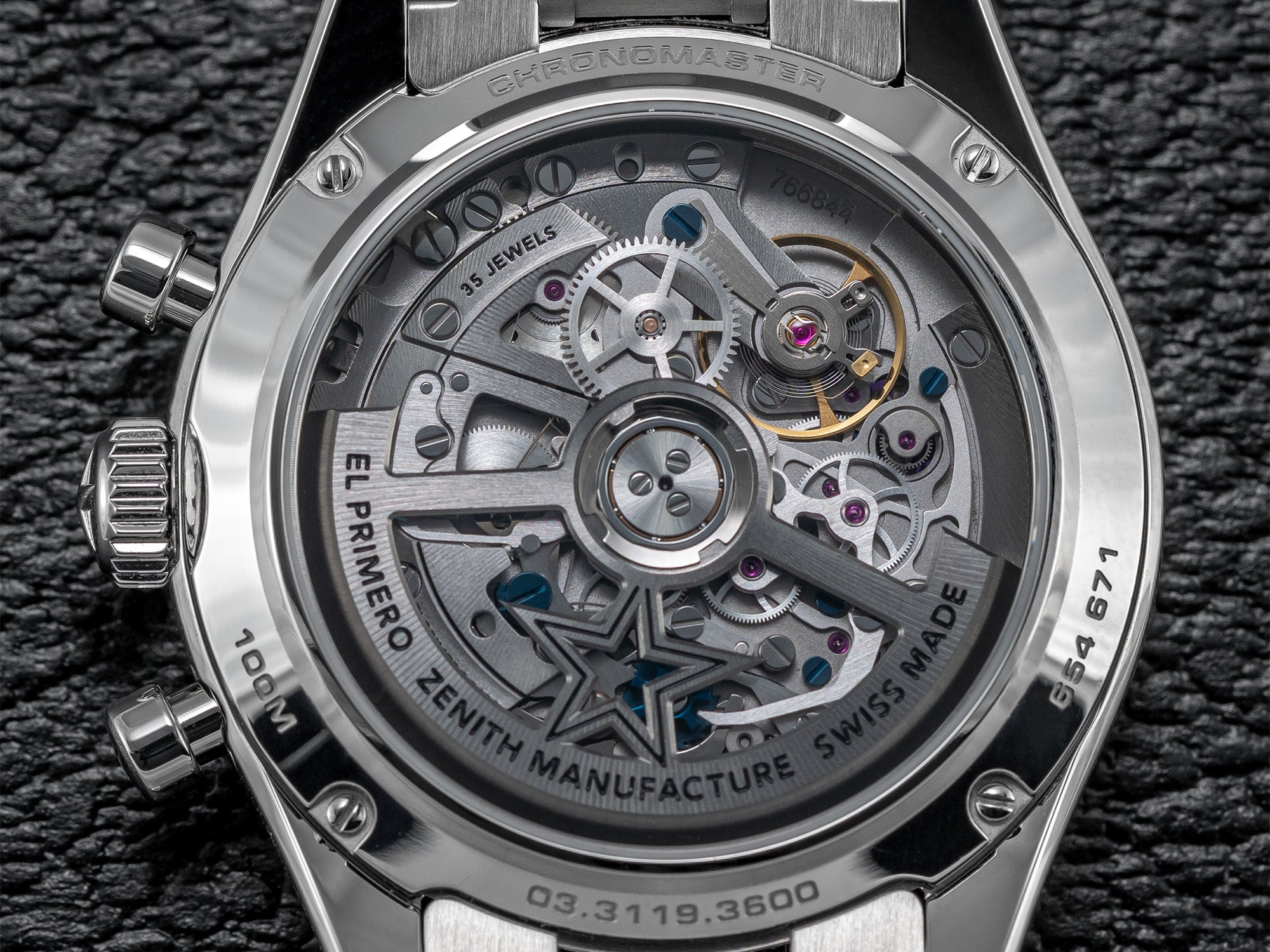
But how did the name “Chronomaster” come to be so closely associated with the classic El Primero chronographs? Bodenmann reveals that the name first appeared on a Zenith watch as recently as 1994, and that the first Chronomaster also featured a significant design feature that many of us might now take for granted. “We wanted to highlight the fact that Zenith was the ‘Master of Chronographs,’” she points out, “and that the El Primero is a caliber that has evolved but still retains its historical legacy. So we made a statement by giving the watch a sapphire caseback. It said that we have ownership of this caliber, and we are proud to be making mechanical watches again after the Quartz Crisis." The Chronomaster line would undergo quite a bit of changes to its design and even its marketing as Zenith (since 1999, part of the LVMH luxury group) underwent changes in vision and leadership, but it remained a core collection for the brand and showcase for the El Primero movement. El Primero calibers (as above) continued to take their place of pride behind the exhibition casebacks.
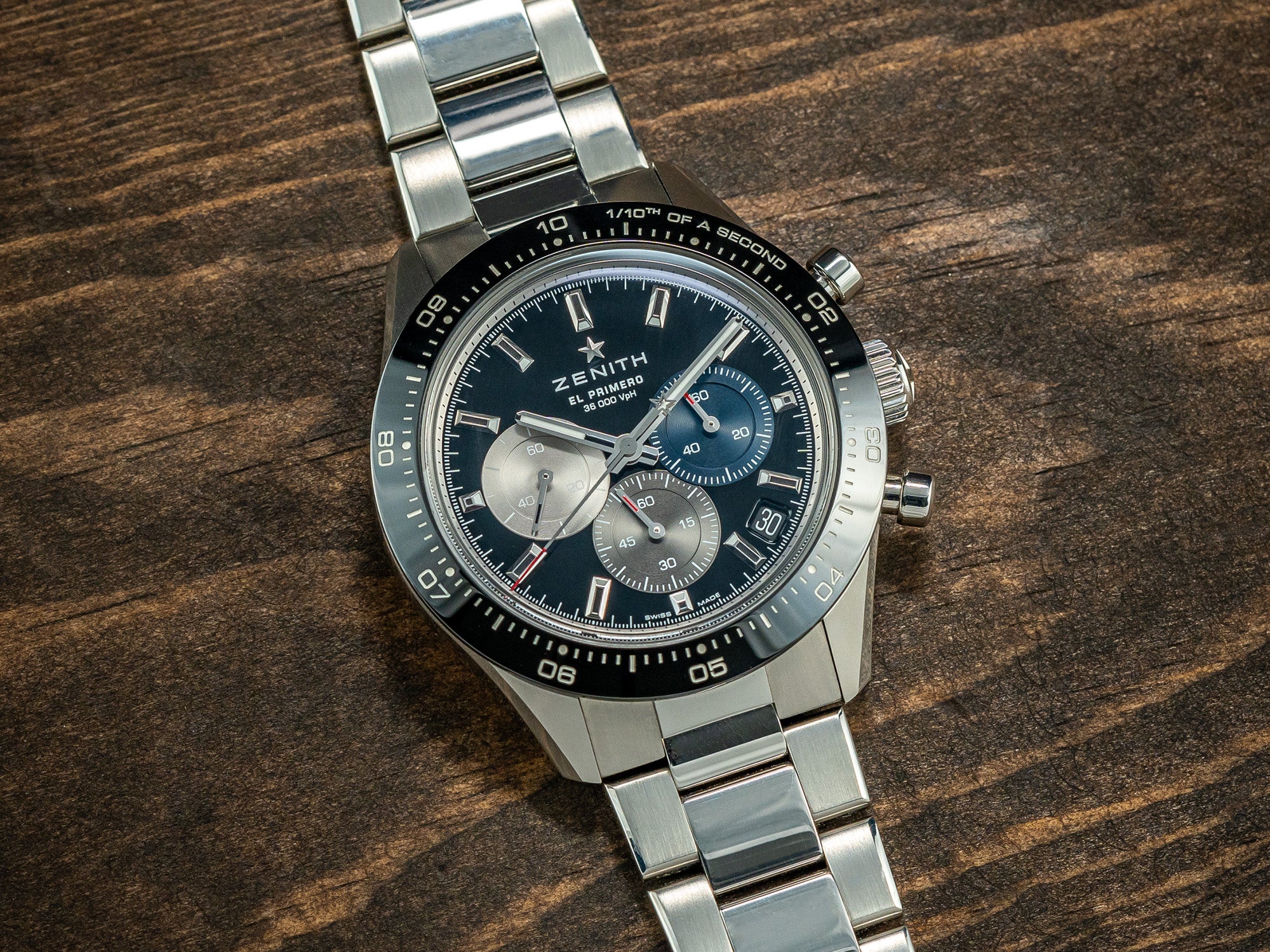
In 2021, Zenith introduced the first Chronomaster Sport, which is, significantly, also the first regular-production Chronomaster model that wears its exceptional chronograph precision on its face as a badge of honor. Distinguishing the Sport models from their siblings in the Chronomaster family, like the more vintage-inspired Chronomaster Original and Revival models, are their bezels — made of polished ceramic and etched with a graduated 1/10-second scale that enables reading of the time to this fraction of a second. Powered by the El Primero 3600 caliber — the latest generation of the legendary movement, optimized both for visual effect, with its enlarged blue column wheel, and for efficiency, with its increased 60-hour power reserve — the watch’s central chronograph seconds hand makes a complete rotation around the dial in 10 seconds rather than the usual 60. This enables the wearer to read 1/10-second readings directly on the bezel when the hand is stopped. The 41mm stainless steel case hosts the vintage-style pump-style chronograph pushers of early El Primero chronographs; the dial’s overlapping subdials are in the familiar blue-anthracite-light gray color scheme of the epochal Ref. A386. Channeling the bold statement first made in 1994 with the original Chronomaster, the movement inside the case is on display behind a sapphire caseback, offering a view of the column wheel, a lever-operated lateral clutch, and an openworked rotor with a Zenith star motif. The first models offered a choice of matte white or matte black dials (above) and were mounted on either a three-link steel bracelet, designed in the style of the classic Gay Frères bracelets of the 1960s, or on a textured cordura-effect rubber strap.
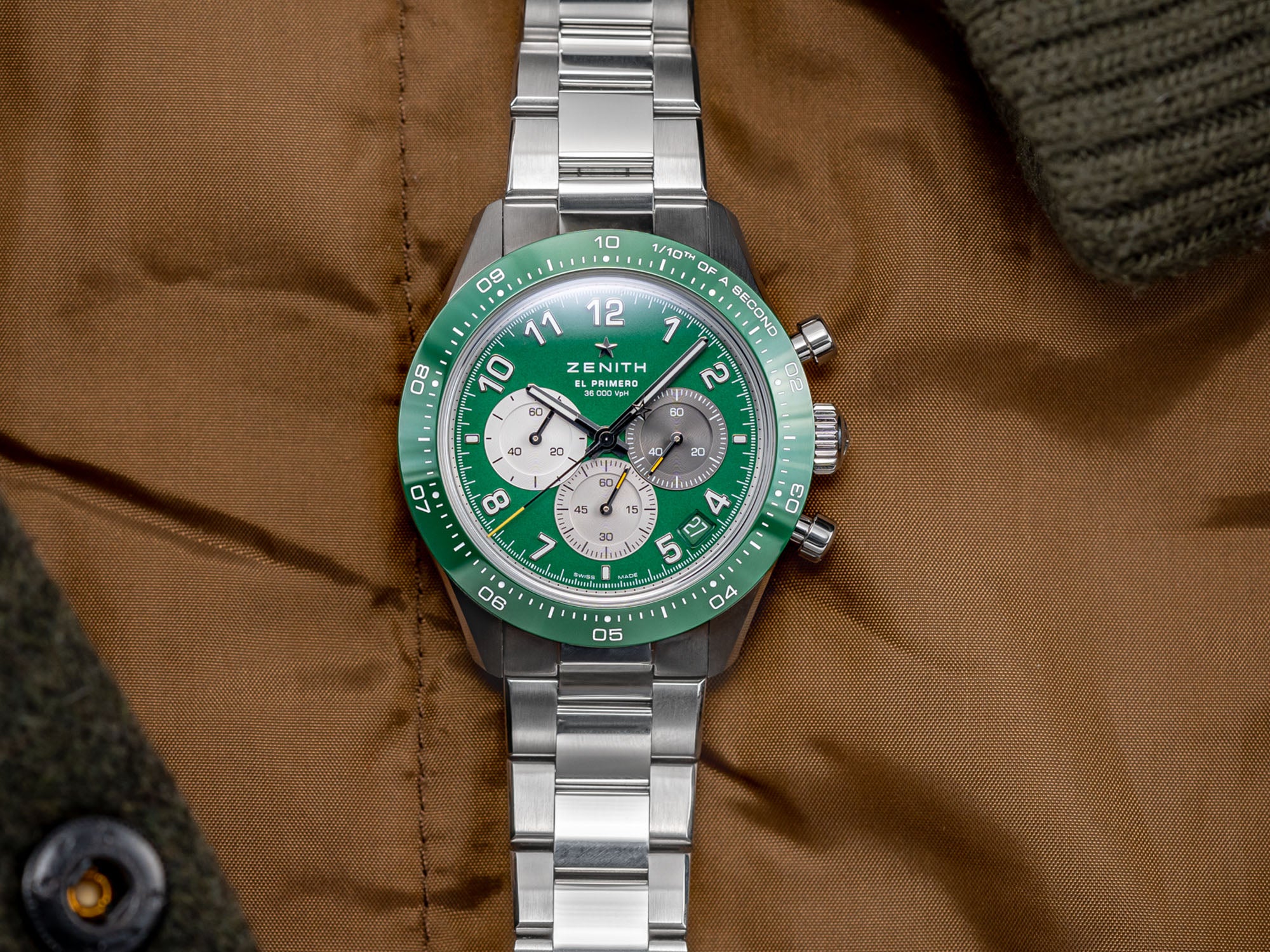
Zenith signed up Super Bowl-winning NFL quarterback Aaron Rodgers, currently with the New York Jets, as a brand ambassador in 2021, right around the time the Chronomaster Sport launched. The brand cemented the partnership in 2023 with the launch of a special limited piece, the Chronomaster Sport Aaron Rodgers Edition. It was the first Chronomaster Sport with a crowd-pleasing green-dominant colorway, matching the green ceramic bezel and its etched 1/10-second scale with a deep green dial. The dial is distinct from those of previous Chronomaster Sports in its use of applied, luminous-coated Arabic numerals, rather than rectangular indexes, at the hour positions. (The latter element was a design contribution by Rodgers, who wanted hour numerals that resemble the numbers on an NFL player’s jersey.) The color scheme of the three subdials has also been reworked to harmonize more ideally with the emerald color of the main dial, with shades of anthracite, light gray, and silver replacing the light gray-anthracite-blue configuration of its predecessors. The watch’s sapphire display caseback, offering a glimpse of the El Primero Caliber 3600 inside, bears Rodgers’ own “AR” logo.

Right on the heels of the Aaron Rodgers edition came the first Chronomaster Sport model with a dial in bright metallic blue (above), which the brand says is a stylistic nod to two of those earlier classic El Primero models: the “De Luca” piece from the late 1980s and the “Rainbow” Chronomaster from the 1990s. In the first significant departure for the Sport sub-family, the 41mm watch features a 1/10-second scale, with black-filled engraved markers, made not of ceramic but stainless steel, the same material as the case, an aesthetic choice that adds a bit of retro appeal to the model. The sunray-finish dial also has a subtle distinction in the hallmark tricolor subdials, with the blue counter differing slightly in finish and tone from the main dial’s blue. A sharp eye will also note the color-matched date wheel, with white numerals on a blue field, at 4:30.
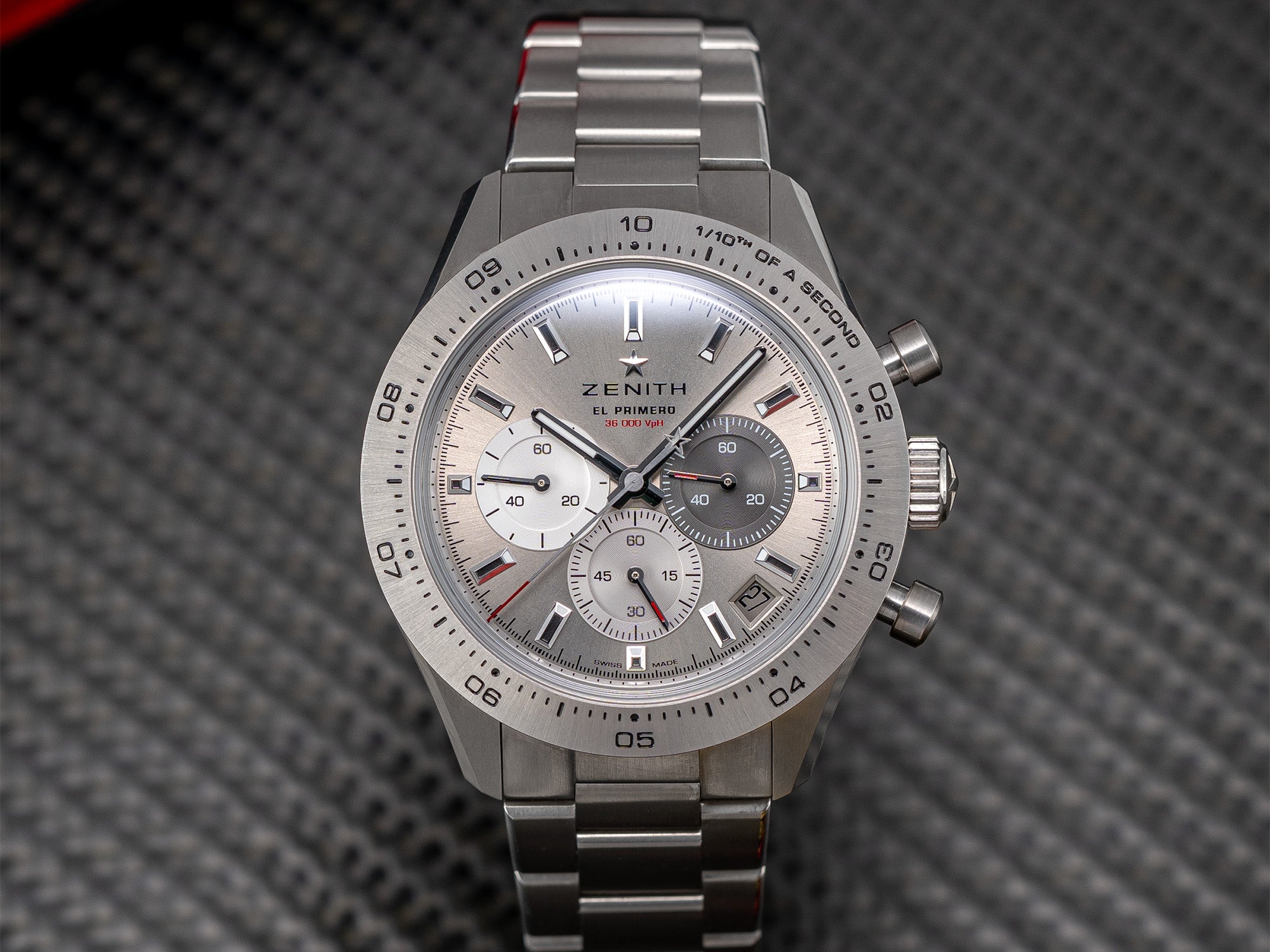 Doubling down on the “Sport” aspect of the collection, Zenith introduced the first Chronomaster Sport model in a full-titanium case and bracelet (above) in 2024 — titanium, of course, being a metal that is lighter and harder than steel as well as paramagnetic and highly corrosion resistant, all properties that make titanium watches ideal for intensive athletic pursuits. The watch’s 41mm case is predominantly satin-brushed, with polishing only on details like the bracelet’s chamfers, and the rim of the bezel and caseback, and the sunray dial is in a galvanic nickel-gray tone that continues the matte metallic aesthetic. The tricolor subdials are also on-theme, with different shades of anthracite, gray, and silver. In addition to the three-link bracelet, the titanium models can also be mounted on a strap of supple, durable FKM rubber, known for its ability to withstand aggressive chemicals.
Doubling down on the “Sport” aspect of the collection, Zenith introduced the first Chronomaster Sport model in a full-titanium case and bracelet (above) in 2024 — titanium, of course, being a metal that is lighter and harder than steel as well as paramagnetic and highly corrosion resistant, all properties that make titanium watches ideal for intensive athletic pursuits. The watch’s 41mm case is predominantly satin-brushed, with polishing only on details like the bracelet’s chamfers, and the rim of the bezel and caseback, and the sunray dial is in a galvanic nickel-gray tone that continues the matte metallic aesthetic. The tricolor subdials are also on-theme, with different shades of anthracite, gray, and silver. In addition to the three-link bracelet, the titanium models can also be mounted on a strap of supple, durable FKM rubber, known for its ability to withstand aggressive chemicals.
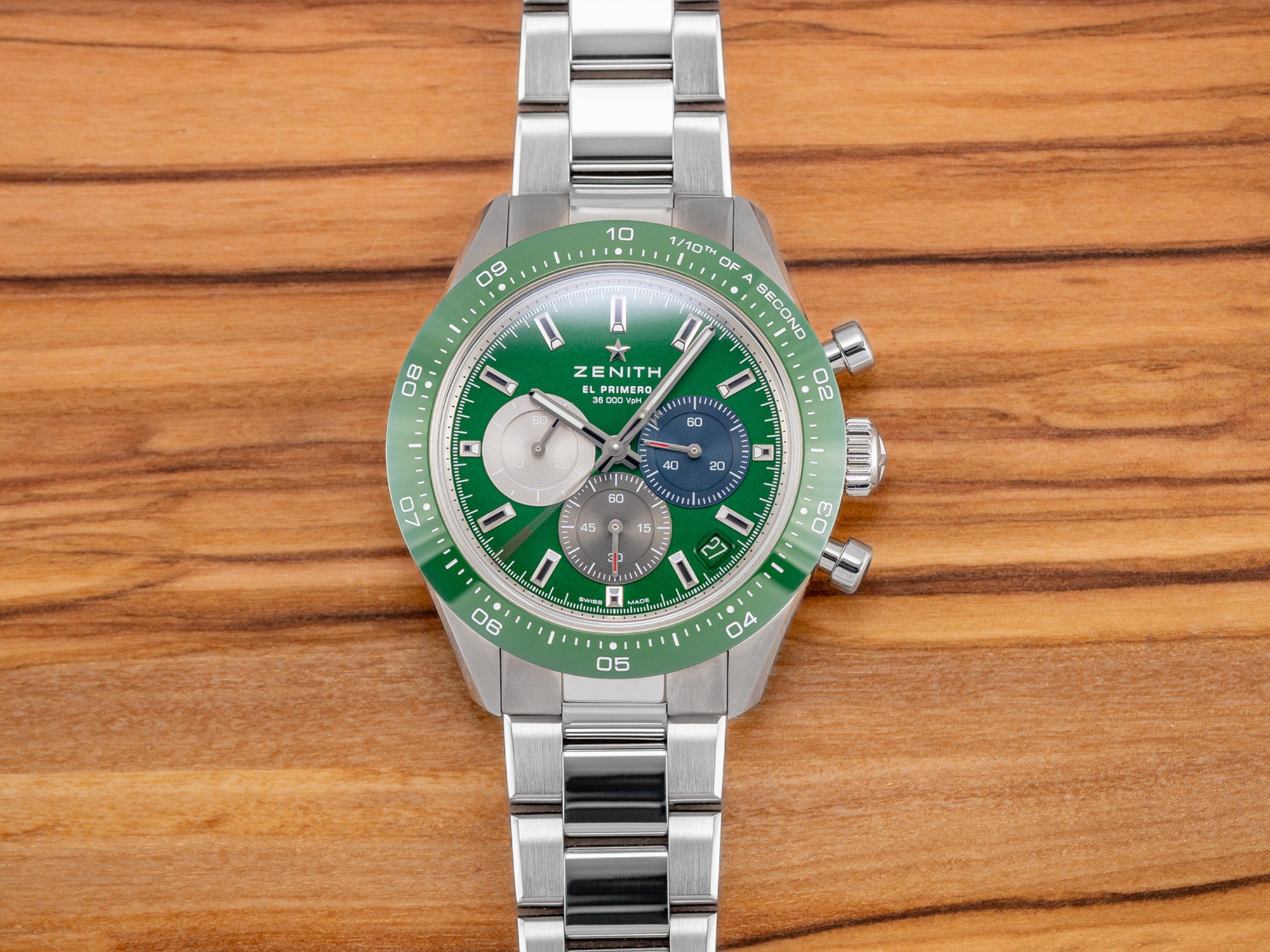
Also available on the new FKM rubber strap, as well as on a steel bracelet (as above), is the latest version of the Chronomaster Sport with a green ceramic dial and lacquered bezel — similar to the Aaron Rodgers Edition but part of the regular collection and which uses the traditional blue and gray colors for the three chronograph subdials, and baton indexes rather than numerals for the hours. Like the blue-dialed model, this one features a color matched date wheel visible at 4:30 and uses stainless steel for its 41mm case, inside which beats the El Primero Caliber 3600.
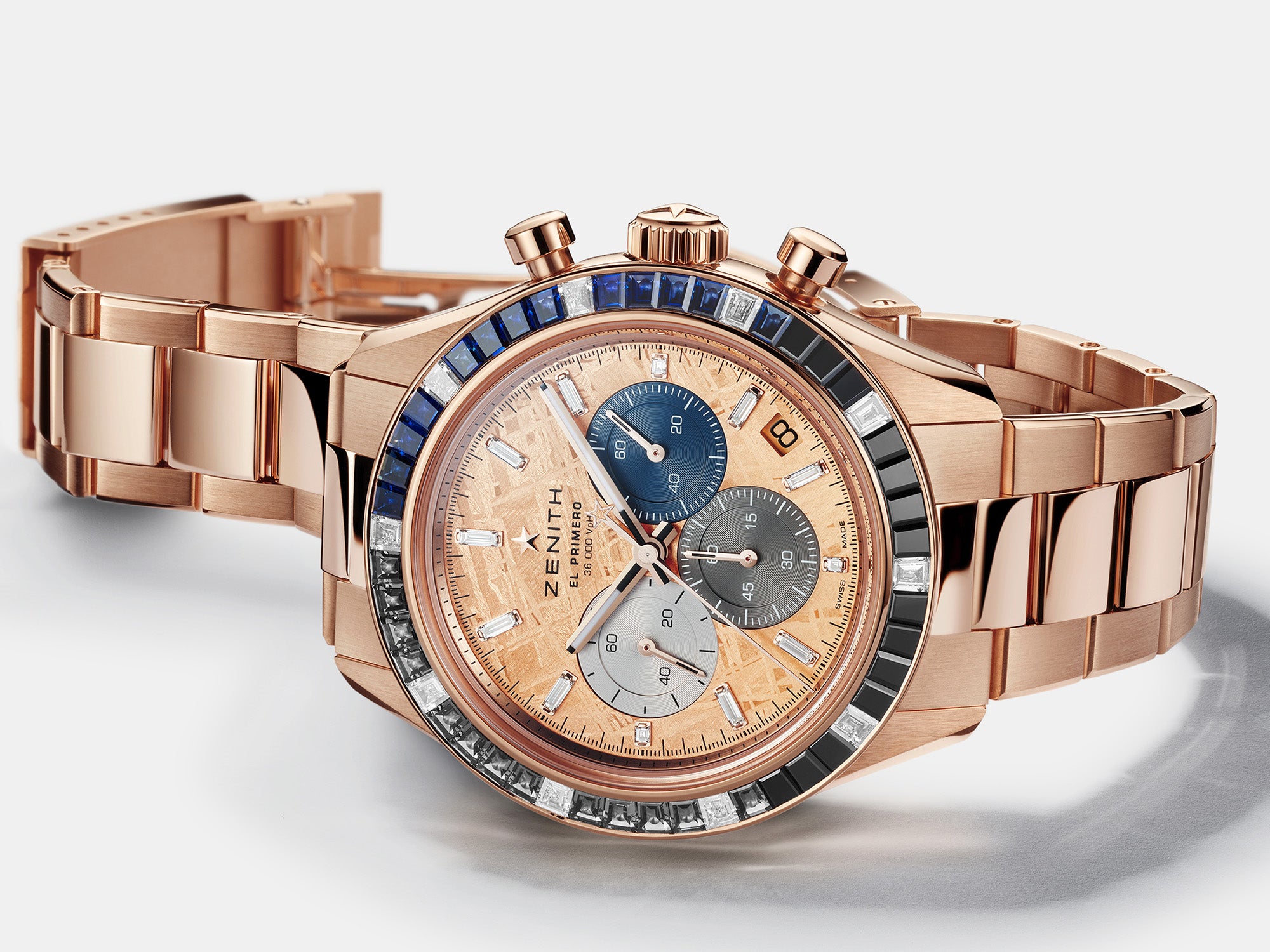
At the upper echelon of luxury and exotic materials, the first version of the Chronomaster Sport with a gold case and bracelet (above) also debuted in 2024, and the precious metal was only part of the story. The dial is crafted from a slab of extraterrestrial meteorite, hand-finished in a warm, golden sheen that accentuates the texture of the meteorite’s Widmanstätten patterns, which are unique on each individual dial. The bezel is fully set with an assortment of diamonds, sapphires, and spinels (5 carats of gem setting in total), while 12 baguette-cut diamonds serve as the hour markers. Speaking to its exclusivity, the Chronomaster Sport in gold with gem-set bezel and meteorite dial is available only at Zenith authorized boutiques.


















































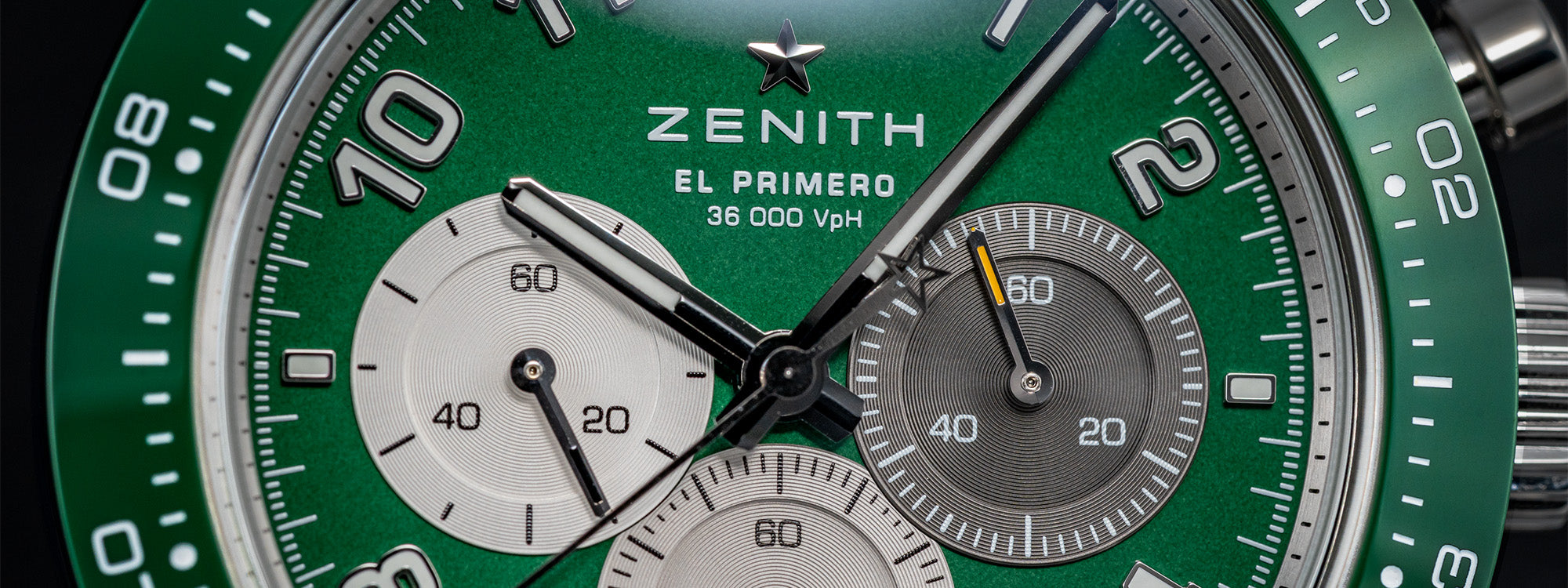



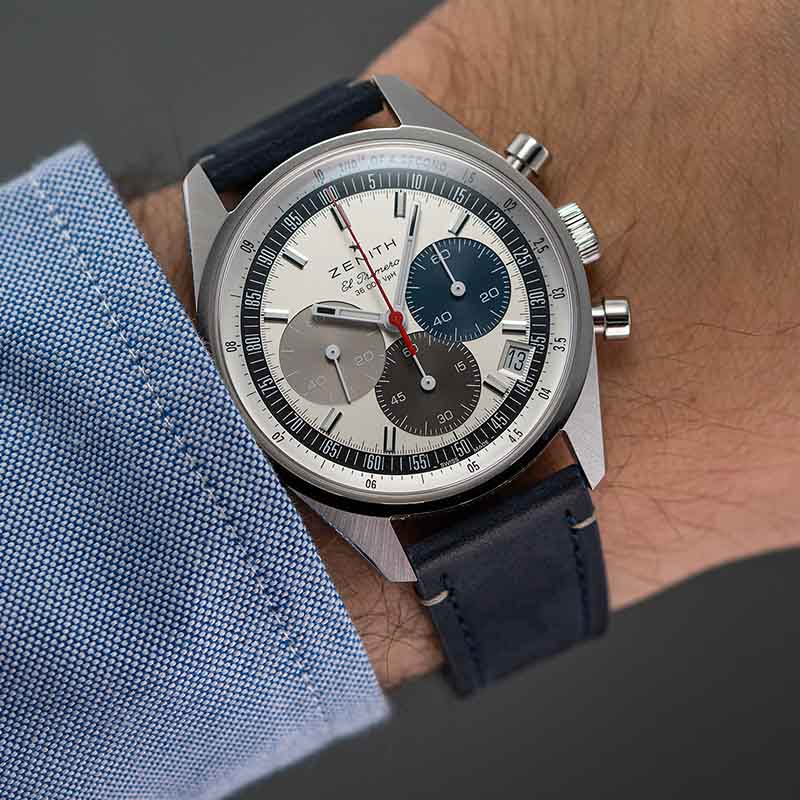
0 Comments